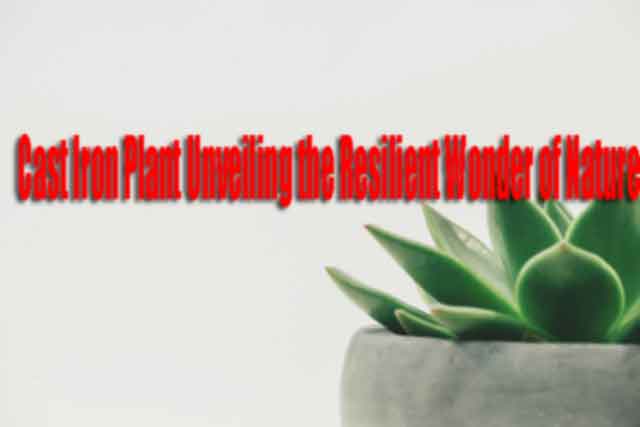Welcome to an insightful journey into the realm of one of nature’s most tenacious creations – the Cast Iron Plant. In this comprehensive guide, we delve deep into the various aspects of the cast iron plant, from its characteristics. And common names to its growth requirements and remarkable resilience. Our mission is to provide you with a detailed understanding of this botanical marvel. Equipping you with all the knowledge you need about the cast iron plant and how to show the beauty of the plant.
What do people use the Cast Iron Plant for?
The cast iron plant is scientifically known as Aspidistra Elatior. Is a versatile foliage plant that has found its place both indoors and outdoors. With its distinctive dark green leaves that display a glossy sheen. The cast iron plant serves as an excellent ornamental addition to gardens, landscapes, and indoor spaces alike. Its hardy nature and adaptability have made it a favorite among gardeners. And interior decorators seeking a touch of elegance that thrives without demanding excessive attention.
Do Cast Iron Plants Need Sun?
One of the most remarkable qualities of the cast iron plant is its ability to thrive in low-light conditions. Unlike many other plants that require ample sunlight for photosynthesis. The iron plant has adapted to survive in the dimmest corners of your home or garden. This characteristic makes it an ideal choice for indoor spaces with limited natural light. As well as shaded areas in your garden that may pose challenges for other plants.
Are Iron Plants Good?
Absolutely, cast iron plants are a fantastic addition to any space, primarily due to their resilience and minimal care requirements. Their ability to withstand neglect, low light, and fluctuating temperatures is unparalleled. Earning them a reputation as one of the hardiest houseplants available. Whether you’re a seasoned plant enthusiast or a novice. The cast iron plant’s forgiving nature makes it an excellent choice for enhancing your surroundings around the world.
What is the Common Name for Cast Iron Plant?
The cast iron plant has earned a variety of common names over time. Including the bar-room plant and the iron plant. These names are a testament to the plant’s robust nature. And its ability to thrive even in environments with unfavorable conditions. The moniker ” iron plant” underscores its durability and strength in any setting.
Why is it Called Cast Iron?
The name “cast iron plant” draws an analogy between the plant’s robust characteristics and the durability of cast iron materials. Just like iron exhibits strength and resilience, the plant also demonstrates a similar unwavering nature when confronted with challenges. This comparison highlights the plant’s ability to withstand neglect and low light. And other challenges, much like cast iron can endure various conditions.
Why do people call it an Iron Plant?
The term “cast-iron plant” is a nod to the plant’s hardiness and unyielding nature. This name encapsulates the idea that the plant is as tough as iron. Able to endure and flourish even when subjected to unfavorable circumstances. With its sturdy leaves and reliable growth patterns. The iron plant lives up to its name by standing firm in various environments.
What are the Characteristics of Iron Plants?
Cast iron plants exhibit a range of distinguishing features that contribute to their unique appeal. Their long, lance-shaped leaves emerge directly from the soil, creating a lush and verdant carpet-like effect. The leaves’ glossy texture adds to their visual charm, while their deep green hue remains vibrant even in low-light conditions. The plant’s growth rate is steady, and its rhizomatous root system aids in its resilience. Allowing it to withstand changing conditions with grace.
What is Cast Iron Production?
While people commonly associate the term “cast iron” with the plant, it also holds industrial connotations. In an industrial context, “cast iron” describes a collection of iron-carbon alloys containing more than 2% carbon content. Experts highly value this form of iron for its exceptional castability. Frequently employing it in manufacturing various items such as machinery, engine blocks, and cookware.
Is Iron Plant Indoors?
The cast iron plant thrives remarkably indoors, which makes it a favored option for homes and office spaces. Its capability to endure low light and infrequent watering fits well within indoor environments. Particularly in situations with limited natural sunlight. Whether you position it in a dimly lit corner or incorporate it into an indoor landscaping project. The iron plant adds a touch of elegance and vitality to interior spaces.
conclusion,
The cast iron plant, with its unyielding resilience, glossy leaves. And ability to thrive in low-light environments stands as a testament to the wonders of nature. Its adaptability to both indoor and outdoor settings, coupled with its minimal care requirements. Makes it a favorite among plant enthusiasts and decorators alike. As you embark on your journey with the iron plant. You’re inviting a piece of nature’s fortitude into your space. Enhancing it with an enduring touch of green.




